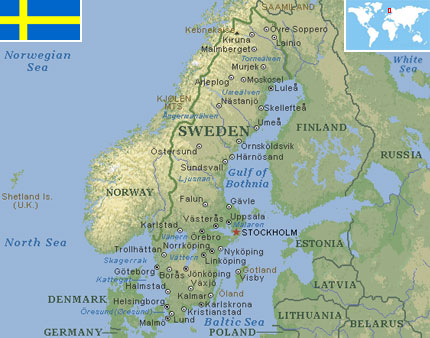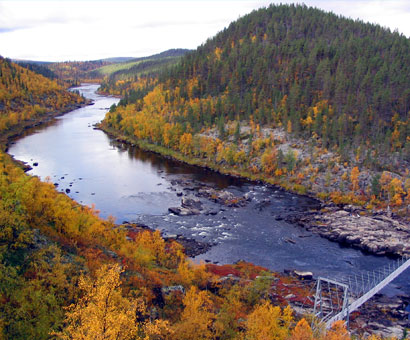Sweden
Country statistics

Land area: 158,927 sq miles (411,621 sq km)
Total area: 173,731 sq miles (449,964 sq km)
Population (2010 est.): 9,074,055 (growth rate: 0.1%); birth rate: 10.1/1000; infant mortality rate: 2.7/1000; life expectancy: 80.9; density per sq miles: 57
Capital City: Stockholm
Monetary unit: Krona
Languages: Swedish, small Sami- and Finnish-speaking minorities
Ethnicity/race: indigenous population: Swedes with Finnish and Sami minorities; foreign-born or first-generation immigrants: Finns, Yugoslavs, Danes, Norwegians, Greeks, Turks
Religions: Lutheran 87%, Roman Catholic, Orthodox, Baptist, Muslim, Jewish, Buddhist
Country introduction

Sweden is the largest of the Nordic countries which borders Norway and Finland and is connected to Denmark via the bridge of Öresund (Öresundsbron). The Baltic Sea lies to the east of Sweden, as well as the Gulf of Bothnia, which separates Sweden from most of Finland. The northern-most part of Sweden belongs to the Arctic.
Essentially one vast coniferous forest punctuated by some 100,000 crystal-clear lakes, Sweden rests within an endless natural beauty. It also reaches far north that one sixth of it is in the Arctic Circle. This means that most people live in the south of the country which can still be very cold, especially in the winter.
The impressive Bohuslän coast takes in a spectacular seascape of 8,000 islands, islets and rocky outcrops from the city of Gothenburg right up to Sweden's border with Norway. Sweden is also known as the capital of cool for exciting cities such as Stockholm and Gothenburg.
The culture

Swedes are egalitarian in nature, humble and find boasting absolutely unacceptable. In many ways, Swedes prefer to listen to others as opposed to ensuring that their own voice is heard.
A well-known national characteristic is their love of nature. Many Swedes like to spend their free time in the forest or by the sea. In Sweden nature is really available to everyone as there is a right of common access which applies to all forests, fields, beaches and lakes across the country.
Sweden is also known for the simplicity of their meals, smorgasbord, Kottbullar (meatballs), smoked reindeer, wild strawberries, and of course, various fish dishes are available throughout the country.
The Swedes celebrate many traditions throughout the year. Some of the highlights include Walpurgis Night on 30 April, when large bonfires are lit across the country as symbols of the passing of winter and the approach of spring. The midsummer celebrations take place in June, on the longest day of the year, which is filled with parties and dancing around the traditional maypole that is decorated with birch leaves and wild flowers. As the summer draws to an end, crayfish parties with snapps and singing are very popular. In the lead up to Christmas there are the Lucia celebrations, where processions of boys and girls in white gowns holding candles charm the crowd with beautiful songs.
Attractions & landmarks

Because of its proximity to the Gulf of Bothnia and the Baltic Sea, watersports are abound in Sweden. Boat trips to the islands, cruises along the historic Göta Canal, waterskiing, golf, windsurfing, cycling, and fishing in Norbotten are some of the activities available. Visitors can also hike through the many national parks including the Swedish Lapland. Sweden also boasts of 96,000 lakes, and beaches stretching hundreds of miles. Winter visitors come for the dog sledding, skiing, ice climbing, and tobogan rides.
To enjoy the history and the culture of Sweden, it is highly recommended to visit the many unique museums in the historic capital city of Stockholm. The city is brimming with landmarks from the past and tourists will not have to look hard to spot many grand buildings, towering landmarks and carved stone fountains. One of most famous of Stockholm's many landmarks is Drottningholm Palace (Drottningholm Slott), the private residence for Sweden's illustrious royal family and dates from the latter part of the 16th century.
Located in Gramla Stan, the Old Town district of Stockholm, the Stortorget (Big Square) is surrounded by a series of grand landmarks and historic structures, such as the palatial Stock Exchange Building (Börshuset), which replaced the town hall and today contains both the Nobel Library and the Nobel Museum. Something a little more modern and up-to-date, both the Globe Arena (Globen) and the Kaknäs Television Tower (Kaknästornet) showcase the city's more recent architecture styles and stand as indisputable monuments to the 20th century.